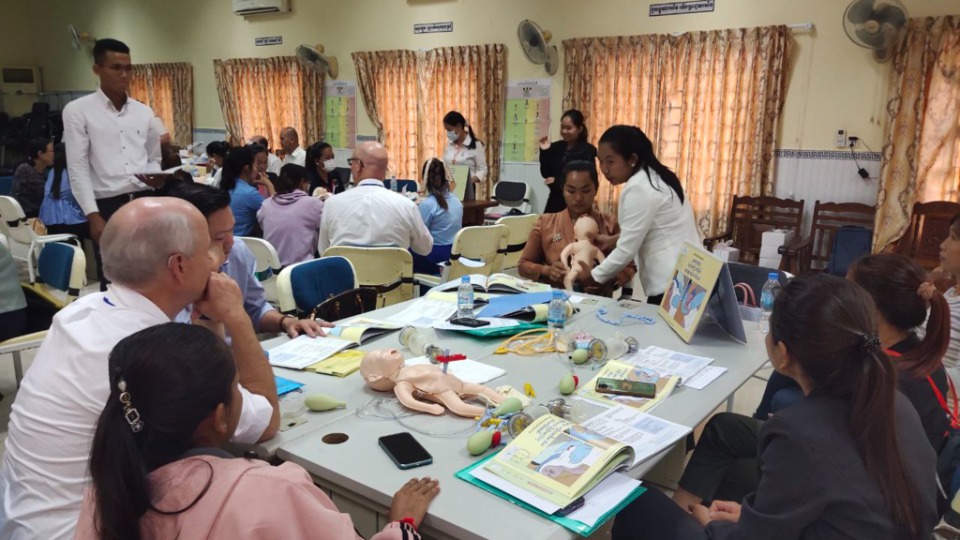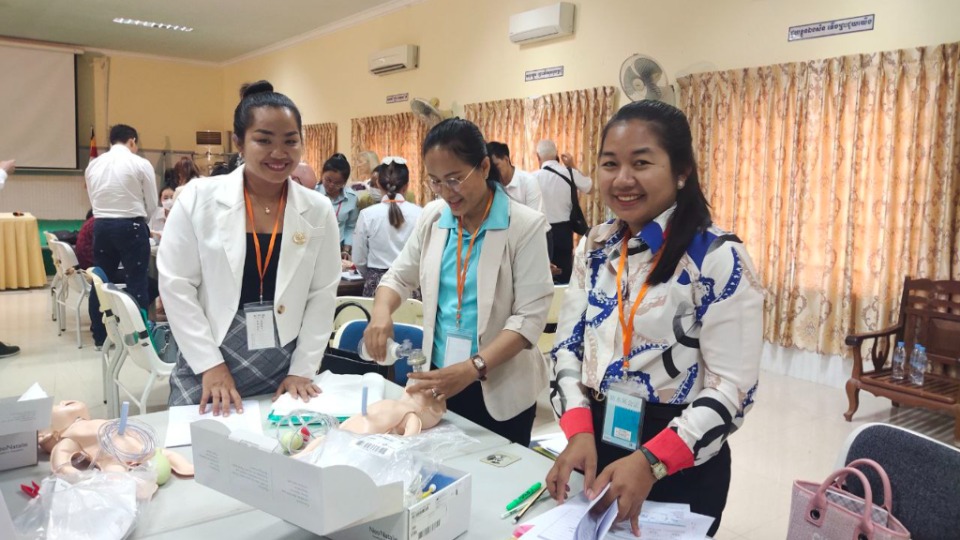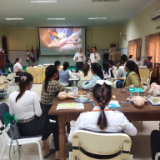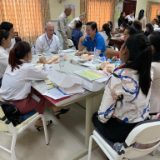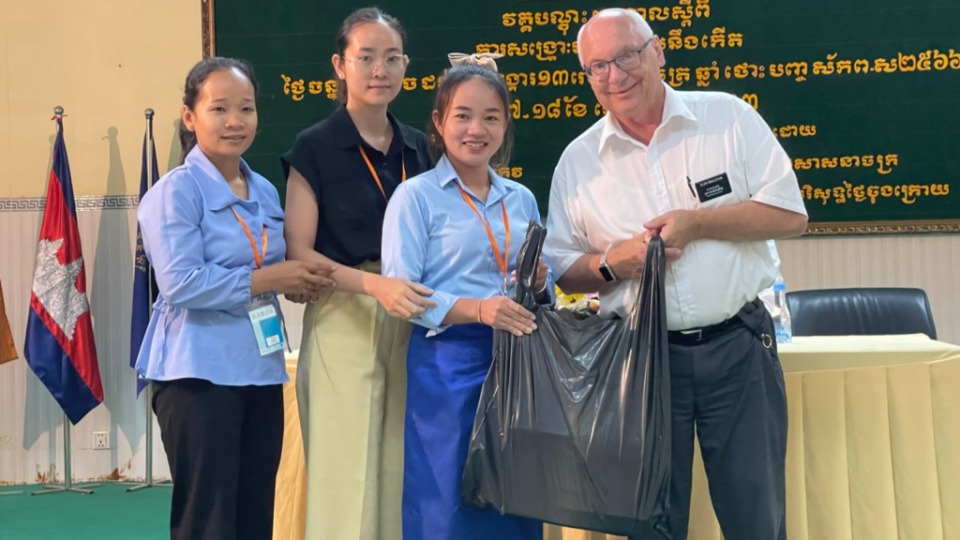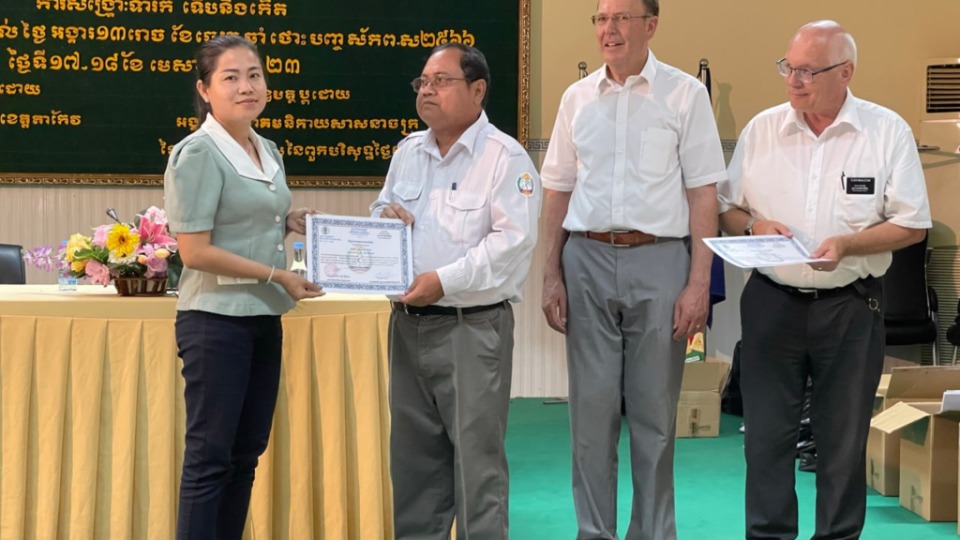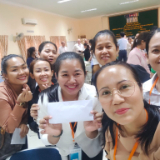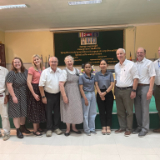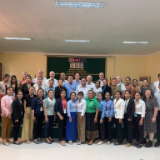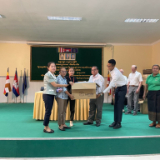ដើម្បីអានជាភាសាខ្មែរ សូមចុច នៅទីនេះ

Neonatal-Resuscitation-Training,-April-2032,-Cambodia.
A Cambodian mother holds her newborn. Medical experts from LDS Charities and humanitarian missionaries of The Church of Jesus Christ of Latter-day Saints volunteered their time and talents to provide lifesaving neonatal resuscitation training to doctors and midwives in Cambodia. The training was provided in the Takeo and Kampong Cham provinces from April 17 to 22, 2023. 2023 by Intellectual Reserve, Inc. All rights reserved.The joyous birth of a child can swiftly descend into tragedy if the baby is unable to breathe. Neonatal resuscitation can make the difference between life and death by restoring breath to the newborn. This critical training was provided to doctors and midwives in Cambodia by medical experts from LDS Charities (LDSC) and humanitarian missionaries from The Church of Jesus Christ of Latter-day Saints who jointly volunteered their time and talents to this endeavor. The Essential Newborn Care (ENC) training project was organized in collaboration with the Takeo and Kampong Cham Provincial Departments of Health and hosted by their respective provinces from April 17 to 22, 2023.
The ENC course is a guide created by the World Health Organization (WHO) that uses up-to-date medical science to train doctors and midwives on how to perform lifesaving procedures for babies. When administered along with the LDSC neonatal resuscitation training program, these doctors and midwives also learn how to instruct other medical personnel in these same skills in order to harness a team-based response to newborn needs. The ENC training project, which focuses on neonatal resuscitation, provides the tools necessary for Cambodian doctors and midwives to help rescue the lives of newborns who are not breathing.
Dr. Mitch Moffit, one of the medical experts on the ENC volunteer team, told the Kampong Cham training participants, “We are excited that you are all learning these important skills, but it will not feel like a success until you start teaching others.” The transfer of knowlege and skills from the LDSC medical experts from the United States, to doctors, midwives and educators from eight districts in the two provinces will have a major impact in helping those trained become self reliant and teach other medical personnel.
| Doctors and midwives participate in the Essential Newborn Care training in the Takeo province of Cambodia. They were instructed by medical experts from LDS Charities of The Church of Jesus Christ of Latter-day Saints, who volunteered their time and talents to provide the lifesaving neonatal resuscitation course. The training was provided from April 17 to 22, 2023 in the Takeo and Kampong Cham provinces. 2023 by Intellectual Reserve, Inc. All rights reserved. | 1 / 4 |
The project requires the new Cambodian instructors to be mentors by returning to their district hospitals, where they will train others with the new skills they have acquired. Thus, with community support from the Provincial Health Departments, the project will become sustainable and improve the circumstances of the Cambodian people in meaningful, permanent ways. Dr. Chin Darith, one of the trainees in Kampong Cham, said, “I am grateful for the training and feel like I can now save a life and help others learn the same skills”.
Dr. Richard Bell, a doctor on the volunteer team who has traveled and taught the program since the 1990s, shared a different perspective on the training's impact. "This training is not just about numbers, it's about a baby and a mother and a family. It is about a child of God. When a baby dies it not only affects the family, but it can also affect the community," he shared. Similarly, the project required a community effort coming together to make it possible.
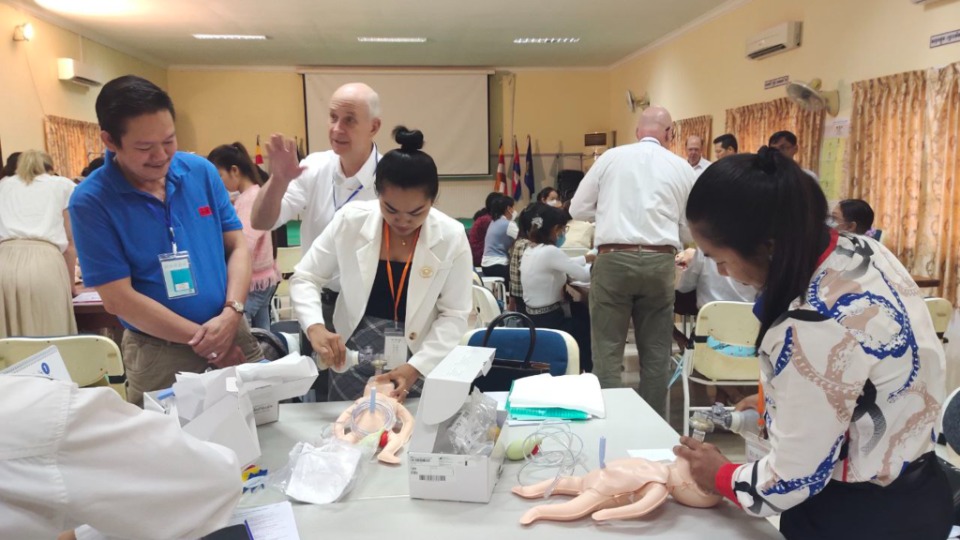
Neonatal-Resuscitation-Project-in-Cambodia,-April-2023.
Volunteer medical expert Dr. Richard Bell gives instruction at the Essential Newborn Care training project in Cambodia, which was a collaborative effort with the Takeo and Kampong Cham Provincial Departments of Health, humanitarian missionaries from The Church of Jesus Christ of Latter-day Saints, and medical experts from the United States under LDS Charities to provide the training in April 2023. 2023 by Intellectual Reserve, Inc. All rights reserved.Dr. Bell and Dr. Robert Clark are doctors from the Church who dedicate their time and service to teaching other doctors, medical personnel, and midwives around the world the lifesaving techniques of neonatal resuscitation training. Dr. Bell and Dr. Clark served together as missionaries for the Church in the early 1970s in Hong Kong. After the introduction of the Neonatal Resuscitation Program by the American Academy of Pediatrics, they began training doctors in China in the early 1990s to help reduce newborn deaths there. The program was eventually adopted by the Church under its LDSC philanthropic arm and volunteer teams were organized to facilitate better training.
In addition to Drs. Bell and Clark, the ENC team to Cambodia included pediatrician Dr. Moffit with Jennifer Jorgenson and Sara Clark, a neonatal nurse practitioner, and a labor and delivery educator respectively. On the Cambodian side, Dr. Nuth Sinath, Director of the Takeo Provincial Health Department, authorized the training program and participated in its closing ceremony. His Vice Director, Dr. Prak Sonnarith, was the Cambodian representative on the training program committee and hosted the training at their department. In Kampong Cham province, the Vice Director of Health Dr. Taing Bunsreng oversaw the training, with Dr. Seang Sody, Dr. Meng Leang, and nurse midwife Pal Sreycy from the National Maternal and Child Health Center all participating as Cambodian instructors. Dr. Sam Kompheak from the Reproductive and Child Health Alliance translated the training documents into Khmer and participated as an instructor as well.
The two groups were brought together by Cambodia Health Improvement Effort (CHIE) humanitarian missionaries from the Church, Elder Brent and Sister Elaine Muhlestein, and Elder Michael and Sister Tanya Chandler. The two couples organized and coordinated the week-long event in Takeo and Kampong Cham, which involved not only the health departments but also hospital directors, local non-governmental organizations, and translators.
Elder Chandler stated, “It was a rather complex project bringing medical professionals and supplies from the U.S. and Cambodia together in two different provinces plus Phnom Penh, but with the extraordinary help of the provincial health directors, the training came off successfully and sets the stage for continuing training throughout the provinces.”
| Midwives from the Takeo Province in Cambodia receive medical supplies from Church humanitarian missionary Elder Brent Muhlestein after completing the Essential Newborn Care training in April 2023. They will take the supplies back to their district hospitals to train other medical personnel. 2023 by Intellectual Reserve, Inc. All rights reserved. | 1 / 6 |
At the event’s end, each trainee was presented with a certificate of successful completion of the course. Additionally, participants from the district hospitals received training equipment and medical supplies to train the medical staff at their respective hospitals, with the hope that it will continue to spread and reach the smaller clinics of rural Cambodia, which also help to deliver babies. Dr. Bell said, “Success is measured not only in training, and lower mortality rates, but also by personal experiences.”
The completion of the ENC project in Cambodia marks another part of the world that the training has spread to. Forty teams are sent out each year to areas in need by the LDSC through partnerships with international agencies such as the WHO, UNICEF, and many others who tirelessly work to improve conditions in developing countries.
The Church of Jesus Christ of Latter-day Saints has a foundational belief in caring for the poor and needy. It is built on the principles of personal responsibility, community support, self-reliance, and sustainability. The purpose of humanitarian efforts is to give individuals and communities the tools they need to improve their own circumstances in permanent and meaningful ways. Neonatal resuscitation is one of six foundational humanitarian programs of the Church.
